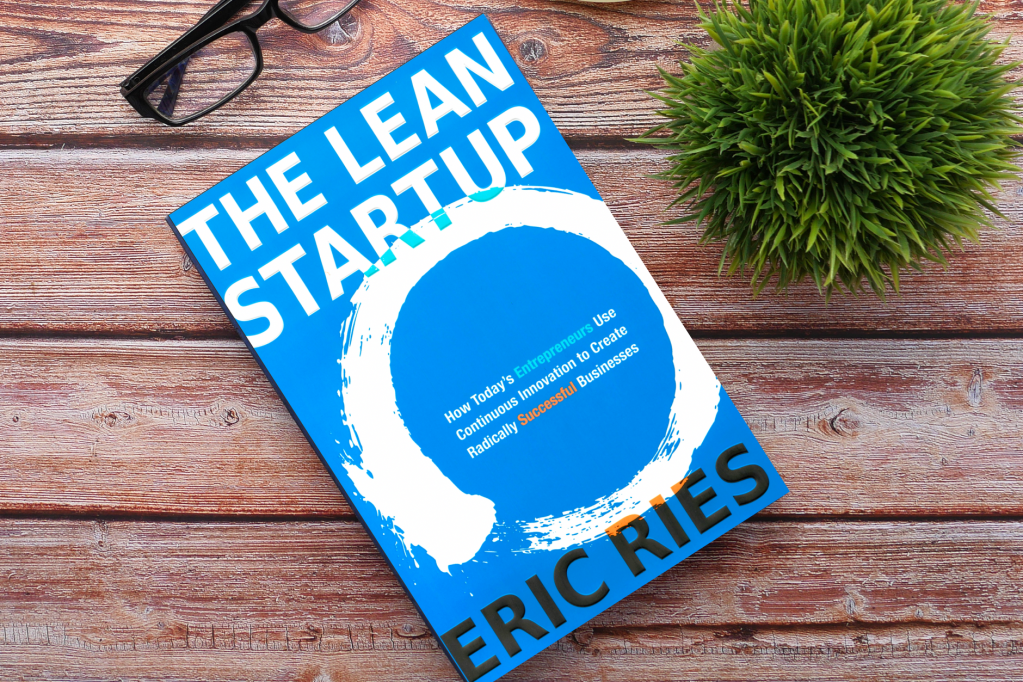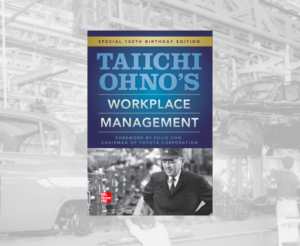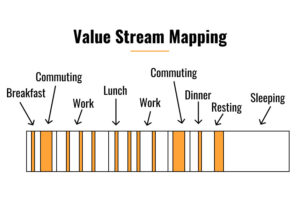Download this executive summary in PDF: The Lean Startup by Eric Ries
Part One – Vision
Chapter 1 Start
- Management and discipline are not contrary to handling the chaos and uncertainty of startups must face.
- There is a loss in manufacturing jobs in the USA during the last two decades but in parallel, there is an increase in manufacturing capacity.
- Companies and startups’ failures are a colossal waste of their people’s time, passion, and skill.
- The Lean Startup takes its name from the lean manufacturing led by Toyota.
The Lean Startup adapts the concepts of lean manufacturing in entrepreneurship.
- The goal of the Lean Startup is to show startups a new way to measure productivity, to figure out the right thing to build, what customers want and pay for, as quickly as possible.
- Drive your company like a car, not like a complex rocket ship.
- Complex plans and wrong assumptions, even if perfectly executed, may lead you to failure.
Constantly adjust with a steering wheel called the Build-Measure-Learn feedback loop.
- Define your vision, the product will be the end result of this strategy.

Chapter 2 Define
- Startup: “a startup is a human institution designed to create a new product or service under conditions of extreme uncertainty.”
A startup is an institution with activities such as hiring, coordinating activities, and creating a company culture.
- A product can be a grocery store, an e-commerce website, or a consulting service that brings value to customers.
- Copying an existing business model is not innovation, the risk and uncertainty are understood.
- Startup projects can start within big companies such as Intuit when management supports innovation.
- Intuit built a system in which testing ideas is fast. Innovation is measured by the number of new customers and the percentage of revenue coming from these offerings.
Chapter 3 Learn
- What is the point to build a product on time and within budget if nobody wants it?
- Failures are costly and should not be used as an excuse by management.
Validated learning is a method for demonstrating progress during extreme uncertainty.
- IMVU is an instant messaging company with a strong network effect.
- Metcalfe’s law: “the value of a network as a whole is proportional to the square of the number of participants”. The more people in the network, the more valuable the network.
- Because it is difficult to change the network for the users, IMVU built an add-on product in which the users can use the IMVU virtual goods and avatar without switching IM providers.
- The first months after the launch, the result was disappointing despite the efforts to make the product better.
- After interviewing users, IMVU discovered that customers didn’t want an IM add-on but a stand-alone IM network. The assumptions they made were wrong.
- Could IMVU learn the lessons from this failure earlier?
One of the lean manufacturing principles is to provide value to the customer and reduce waste.
- After learning what the users really valued, IMVU pivoted in its product development. IMVU was more suited to making new friends.
- Delaying launching the product is a temptation to keep dreaming of an overnight success.
- Bad results are cold water poured onto the dream of success.
- Every experiment should help to answer these two questions: “Should this product be built?” and “Can we build a sustainable business around this set of products and services?”
Chapter 4 Experiment
- The scientific method is if you cannot fail, you cannot learn.
Begin with a clear hypothesis that makes predictions about what is supposed to happen, then test it empirically.
- Start with small experiments. The founder of Zappos sold the first shoes online by posting a few pictures online. He got direct feedback from customers before building any product.
- The value hypothesis tests whether a product or service really delivers value to customers.
- The growth hypothesis tests how new customers will discover a product or service.
- Fast negative results are instructive and can influence the strategy.
- Unlike market research, the experiments have already solved real problems and have established customers.
- Do consumers recognize that they have the problem you are trying to solve? If there was a solution, would they buy it? Would they buy it from you? Can we build a solution for that problem?
“Success is not delivering a feature; success is learning how to solve the customer’s problem.”
Part Two – Steer
Chapter 5 Leap
- At the beginning of Facebook, traction was already strong, more than half of the users came back to the site every day, and three-quarters of Harvard’s students were using it within one month. The growth hypothesis was validated.
The strategy is based on assumptions that must be tested without losing the vision.
- Analog: when launching the iPod, Steve Jobs knew people would listen to music with earphones because people were already using Walkman.
- Antilog: people were downloading music for free on Napster. Will people pay for downloading music?
- Being at the right place and at the right time is not a guarantee of success. The ones who succeed are the ones who adapt their strategy.
- Genchi gembutsu, go and see for yourself. Yuji Yokoya was in charge of the development of the new Sienna minivan for the North American market. He traveled in a Sienna minivan for 53,000 miles in the USA to experience and observe what customers wanted.
- Get out of the building and go ask customers is a good way to understand their problems.
- Designing the customer archetype and his problems will guide your product development.
Analysis paralysis is endlessly refining the plan, it is dangerous it lacks real feedback from customers using the product.
Chapter 6 Test
A minimum viable product (MVP) is designed to test the business hypotheses as fast as possible.
- Early adopters are a breed of customers willing to pay to use a new product first even if it is not perfect yet.
- Extra features beyond the minimum to start testing and learning is a waste.
- Dropbox showed a demonstration in a video to early adopters while the product was not built yet.
- At Food on the Table, the CEO provided a concierge MVP. He served the client face to face. It was very inefficient and not scalable, but he learned about real-life problems the client had and developed features that were really needed.
Making quality products is the foundation of lean manufacturing. But for a startup, we don’t know for sure who the customer is and what he perceives as worthwhile.
- Build your MVP and let the customer decides if it is what they want or not.
- The probability that competitors steal the idea of your MVP is very low. They already have many projects.
- The only way to stay ahead of the competition is to learn faster through the Build-Measure-Learn feedback loop.
Chapter 7 Measure
- How to be certain that the product is becoming better? The improvement in the numbers is maybe not the direct result of the changes in the product.
- The rate of growth depends on the profitability of each customer, the cost of acquiring new customers, and the repeat purchase rate of existing customers.
- Another business model is eBay which relies on the retention of new buyers and sellers.
If the strategy is flawed, the company can pivot.
- Use the MVP to test your assumptions. A MVP can be as simple as some marketing materials. Do the customers want to sign up or preorder the product?
- Then, fine-tune the engine to improve one of the drivers of its growth model.
- Test and measure one hypothesis at a time, you will know if you are moving in the right direction.
- A cohort analysis is similar to a funnel analysis in sales.
- Poor quantitative results force to do more qualitative research with new hypotheses.
Optimization improves the product’s performance. However, incremental efforts to build the wrong product in a startup will not yield results.
- When there is no result, managers blame the engineers for not working hard enough while working on the wrong features.
- Vanity metrics prove that the company’s growth engine is working, but presented in a cohort style, you cannot confirm whether you are building a sustainable business.
- Agile is a methodology in product development. The sprints deliver new features, they change direction quickly according to the feedback.
- Using A/B testing and cohort-based metrics helps distinguish what features impact customer behavior and what they want and don’t want.
Developing features that have no impact on customer behavior is a big waste.
- The kanban diagram is a tool to prioritize and monitor feature development. Feature development is split into four stages: backlog, in progress, built, validated.
- Three A’s of metrics: actionable, accessible, and auditable.
- An actionable metric is when cause and effect are clearly defined.
- Accessible means the data is easily understood by everyone.
- Data must be auditable, managers should be able to test the data by talking with customers.
Chapter 8 Pivot (or Persevere)
- There is not a scientific formula to tell when to persevere or pivot.
Being stuck in the land of the living dead is when the MVP is improving but the data are still mediocre. Should the startup pivot or persevere?
- The zoom-in pivot is focusing the product on one feature.
- The customer segment pivot is keeping the product but switching the audience who will pay.
- The platform pivot is a self-serve platform where anyone can become a customer with a credit card such as Adwords.
- A startup can keep learning and pivot as long as the company has remaining cash in the bank.
- When cash is low, either they cut the costs or raise additional funds.
Pivoting requires courage: admitting the fear of failure, refusing to look at the vanity metrics, and knowing exactly the criteria of failure.
- Only looking at the vanity metrics during growth is a trap.
- Reaching the mainstream customers is the next challenge after converting the early adopters.
- Mainstream customers have different expectations and pivoting might be necessary to sustain the growth.
- Pivot is a kind of change designed to test a new fundamental hypothesis.
- Zoom-in Pivot: a previous single feature becomes the whole product.
- Zoom-out Pivot: the whole product becomes one feature of a larger product.
- Customer Segment Pivot: the product solves a problem but not the original customers planned to serve.
- Customer Need Pivot: Because of customer intimacy, a bigger problem is discovered that needs to be solved.
- Platform Pivot: Switching from an application to a platform or vice versa.
- Business Architecture Pivot: Switching from the high margin, low volume to low margin, high volume, and vice versa.
- Value Capture Pivot: Monetization or revenue models.
- Engine of Growth Pivot: viral, sticky, and paid growth.
- Channel Pivot: A channel is a mechanism by which a company delivers its product to customers.
- Technology Pivot: the company discovers a new technology to solve the problem more efficiently.
Part Three – Accelerate
Chapter 9 Batch
- Doing one at a time (single-piece flow) than in a large batch is faster and more efficient.
- Large batch has waste such as sorting, moving, and stacking.
- Producing in small-batch helps to detect quality problems sooner and avoid rework.
- After WWII, Japanese carmakers were unable to compete with American factories in the mass production of large batches. Innovators such as Taiichi Ohno and Shigeo Shingo found a way to succeed by using small batches.
The Lean Startup goal is not to produce widgets more efficiently but to learn how to build a sustainable business as quickly as possible.
- Continuous deployment: when a defect is detected, it is removed immediately, the team in charge is notified, and no more introduction of further changes prevents the problem from compounding until the root cause of the problem is found and fixed.
- This small-batch development works also in hardware, design, and 3D prototyping for example.
- Traditional education is designed on mass production and large batches. Some startups are building educational systems around the small bath concept.
- In design, large batches increase the risk of wasting time doing rework when designers pass a defect to engineering. Drawing must be redone and engineers may become idle.
- The large-batch death spiral: the management is afraid to launch the product because the more they worked on the project with many features higher the expectation. The big product comes with more bugs that need to be fixed.
- Incomplete designs, not-yet-validated assumptions, and business plans are work-in-progress.
- Using the Pull method instead of the Push method reduces WIP. Same as on a shop floor, WIP piles up.
- With the Pull system, you produce the product needed by the customer in the quantity required.
In the Lean Startup model, as customers don’t what they want, the idea is to produce experiments that need to be run.
- Define the hypothesis about the customer that needs to be tested then launch the Build-Measure-Learn loop as quickly as possible.
Chapter 10 Grow
- Sustainable growth: new customers come from the actions of past customers.
- Growth comes from word of mouth, as a side effect of product usage, through funded advertising, and through repeat purchases or use. There are 3 engines of growth.
- Sticky engine of growth: the product attract and retain customers for the long term.
- Customer acquisition exceeds the churn rate.
- Churn rate: fraction of customers in any period who fail to remain engaged with the product.
Customers should have a compelling reason to have a repeat usage of the product and not switch to a competitor.
- Viral engine of growth: similar to a virus, awareness of the product spread rapidly. Each customer brings with him more than one other customer, the viral coefficient is greater than 1.0.
- Companies that have a viral growth strategy focus on increasing the viral coefficient by eliminating frictions.
- Paid engine of growth: increase its rate of growth by increasing the revenue from each customer or driving down the cost of acquiring a new customer.
- The lifetime value is the total revenue that each customer will bring to the company.
- If the lifetime value of a customer is superior to his cost of acquisition, the product will grow.
- It is technically possible to have more than one engine of growth at the same time but specializing in one engine reduces confusion.
- Product/market fit: the startup finds a widespread set of customers that resonate with its product.
- Pivoting is not a failure event, and a product that has achieved product/market fit may still need to pivot.
- The growth engine will eventually run out, and the set of customers will be exhausted.
If the startup is relying on its growth engine for growth without improving its product, the company will face a crisis when the growth engine is exhausted.
Chapter 11 Adapt
Adaptive organization: automatically adjust its process and performance to current conditions.
- Speed is crucial in learning how to build a sustainable business but destructive if it is not regulated.
- At Toyota, the andon cord will stop the line of production when a defect is detected to surface the problem and solve it once and for all.
- Defects will slow you down later and cause rework and customer complaints.
There is a paradox between shipping the MVP with bugs to learn and building a quality product.
- Asking Five Why helps to discover the root cause of the problems.
- Technical problems are often a human error.
- Invest time and money proportionally to the problem to be solved.
- Training is an investment to reduce problems down the road.
- Five Blames: when a problem occurs, teammates may start pointing fingers at each other.
Solve the problem at a system level and avoid blaming people.
- During the analysis of the root cause, anyone who is concerned should be invited. Whoever is left out of the discussion ends up being the target for the blame.
- Build the culture by being tolerant of the mistakes the first time. Blame the system, not the people.
- Start with a small and specific problem to practice.
Chapter 12 Innovate
The 3 prerequisites for innovation are scarce but secure resources, independent authority to develop their business and a personal stake in the outcome.
- Capital in a startup must be secure. A sudden reduction of 10% of its cash on hand can be a fatal blow.
- Approvals slow down the Build-Measure-Learn feedback loop and inhibit learning and accountability.
- A personal stake in the outcome can be a financial incentive or reputation.
- Innovation can be inhibited by fear when there is a lot to lose in case of a mistake.
- Hiding the innovation from the parent company doesn’t build sustainable innovative culture and trust.
- Contain the impact of the innovation without constraining the methods by giving the boundaries and rules.
- Entrepreneur should be a job title, entrepreneurship should be considered a viable career path for innovators inside large organizations.
- How do we know that the problem is due to a special cause versus a systemic cause?
- When adopting the Lean Startup methodology, it is tempting to blame the new system for the problems.
Epilogue: Waste Not
- Frederick Taylor puts the system above the people but lean manufacturing proves that factory workers can also bring value.
The problem today is not to know how to produce more but if the product should be built. Producing efficiently the wrong thing is a big waste.
Download this executive summary in PDF: The Lean Startup by Eric Ries









